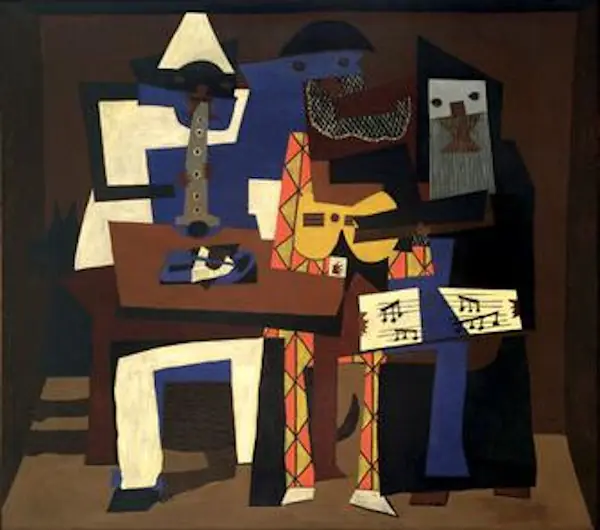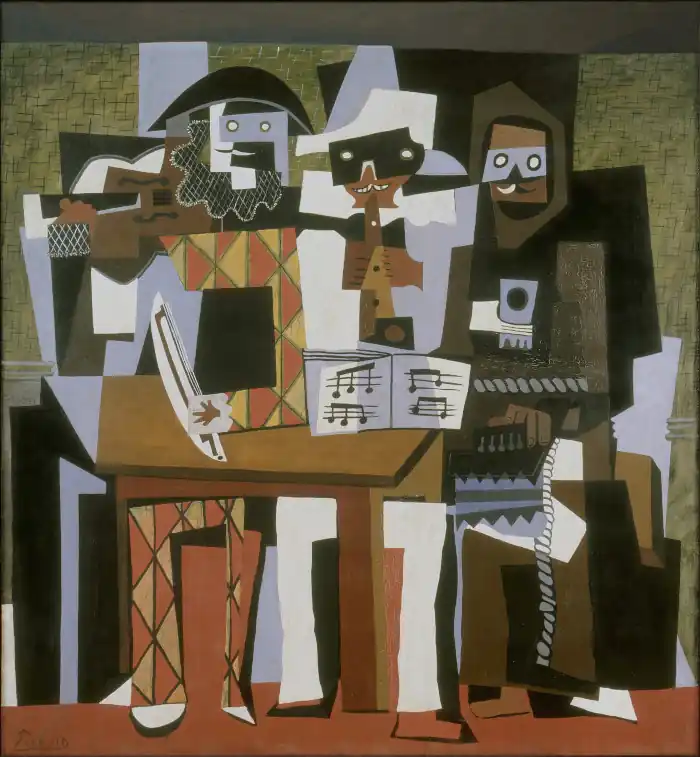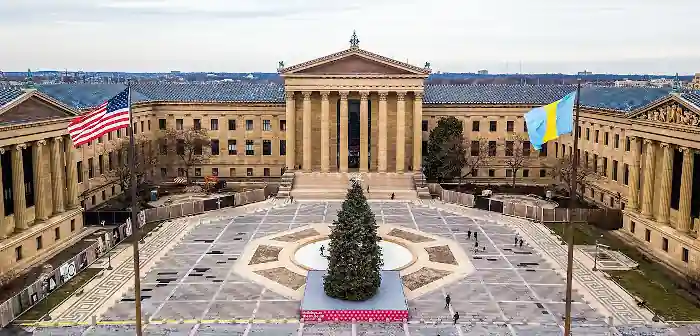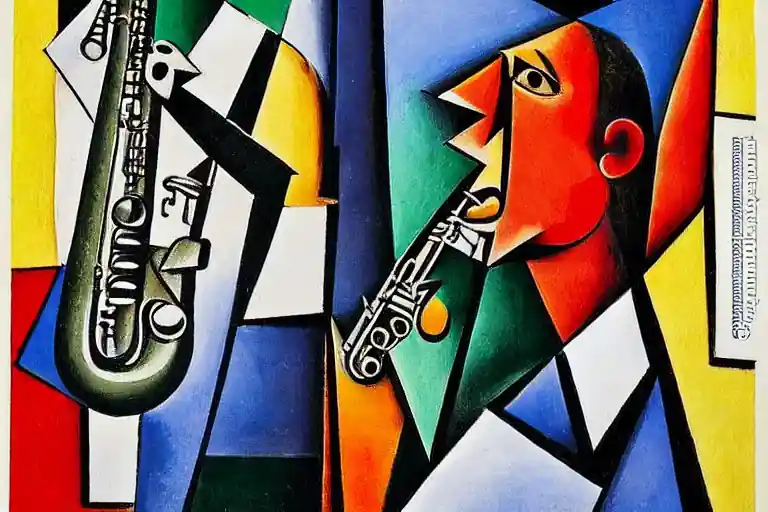In response to the fast-transforming modern environment, Pablo Picasso founded the revolutionary modern art movement, Cubism. One of his most famous cubism artworks is the “Three Musicians.” What are these three musicians playing in the painting? Having the appearance of merely cut papers, what do they symbolize and portray?
The instruments played by Picasso’s “Three Musicians” are a guitar, a clarinet, and singing. The painting shows a monk holding music sheets, a harlequin or clown with a guitar, and a Pierrot with a clarinet. This masterpiece uses a small, box-like setting and flat, colorful, abstract elements.
Picasso’s famous art movement Cubism is perfectly exemplified in the painting Three Musicians. The painting uses a series of planes, lines, and arcs. Read on to learn more about the painting’s background and the symbolism and themes it exemplifies.
Three Musicians Background
Table of Contents
Three Musicians is the title of two similar oil paintings by Pablo Picasso. Both paintings’ styles are flat and broken up, with simple shapes and colors used to make a dynamic composition. People think of these two paintings as masterpieces of early modern art, and they show how Picasso used new techniques to make art.
Picasso created the painting in 1921 in Fontainebleau to the south of Paris. It is rumored to be a piece from a series he painted in the summer of 1921 while spending time with his family. [1]

With these paintings, Picasso applied his Synthetic Cubist style. Picasso produced the piece of art regarded as the earliest instance of collage and a key example of Synthetic Cubism in 1912. Picasso intended to revive Cubism by removing it from its former approach after his works had grown too formulaic. Picasso experimented and began attaching genuine items to his works, thus turning them into collages.
Some of Picasso’s artworks that fall under Synthetic Cubism are:
- Still Life with Chair Caning (1912)
- Bottle of Suze (1912)
- The Guitar Player (1910)
- Glass and Bottle of Suze (1912)
- Violin (1912)
- Man with a Guitar (1911-1912)
- Mandolin and Guitar (1924)
- Three Musicians (1921)
- The Pipes of Pan (1923)
- Harlequin with Guitar (1918)
The three musicians in his artwork are wearing masks. Pierrot, the one playing the clarinet, wears a cone–shaped white hat and a black eye mask. On the other hand, the harlequin has an eye mask with two holes drilled within it for brown eyes. Yet, the mask enlarges to the left, obscuring different features. [2] Lastly, the monk is clad in a long, black hooded habit.
Two of the three musicians wear costumes popular in the Italian theater, specifically the pierrot and the harlequin, both prominent figures in the Commedia dell’arte, which was famous throughout Europe between the 16th and 18th centuries. Masks were a big part of this type of theater, which led to actors and performances that needed to follow a script or scenario.
What Are the Symbols and Themes of Three Musicians?
The harlequin is one of the musicians in Three Musicians– a popular character in Picasso’s Rose Period paintings. Throughout the Rose Period, harlequins, circus performers, and clowns frequently feature; they continue to do so throughout the rest of Picasso’s extensive career.
The pierrot is playing the clarinet on the left.
In the Commedia dell’arte, a clown pierrot is a naive romantic who frequently experiences heartbreak. The charming con artist harlequin is usually the object of his affection.
The harlequin is playing guitar and is dressed in red and yellow colors that represent the Spanish flag. In sharp contrast to the melancholy clown, the harlequin’s role is a slick and knowledgeable servant. [3]
Lastly, the monk on the right sings and holds sheet music. Monks are also often included in performances in the Comedia dell Arte.

A dog is also hiding under the table while the musicians are playing. A table with a pipe and other items sits in front of the pierrot, and a dog is underneath him, its belly, legs, and tail sticking out from behind the musician’s knees.
The three musicians might represent Picasso, Guillaume Apollinaire, and Max Jacob. The harlequin is said to be depicting Pablo Picasso himself, the pierrot, his friend Guillaume Apollinaire, and the monk Max Jacobs, Picasso’s friend who entered a monastery. [4]
In 1921 when Three Musicians was painted, Max Jacobs became a monk. Three years earlier, Guillaume Apollinaire died of the Spanish Flu. Because of this, it is often theorized that one of the reasons why Picasso made Three Musicians is because he was missing his friends and reflecting it through his work.
In the second version of the piece, the harlequin and the pierrot swapped places, but the monk’s place was retained. The monk is still the figure in the rightmost of the group.
Perhaps another painting featuring a musician that can be linked to Cubism is one created by Henri Matisse, Picasso’s art rival. He painted “The Piano Lesson” in 1916. It is a very abstract artwork that is significant for its relationship to the Cubist grid created by Pablo Picasso and its biographical elements and insightful iconography. [5]
Where Are The Three Musicians Paintings Located?
The first version of the well-known piece is currently on display at the Museum of Modern Art in New York. It represents a return to Picasso’s enduring fascination with the Commedia dell’Arte, his return to high Synthetic Cubism, which he first explored in his early days as an artist in Paris.
The second version is in the Philadelphia Museum of Art, one of Philadelphia’s first and most prestigious art institutions. Their 200,000-item collection reflects the history and the interests of many generations of curators and collectors.

Lillie Plummer Bliss donated the collection to the Museum of Modern Art – she was one of the leading NYC collectors of modern art. She also served as the vice president and one of the founding members of the Museum of Modern Art. She had a significant role in both the organization’s founding and operation. [6]
Lillie came from a family of textile merchants, and her father was Cornelius Newton Bliss. From 1897 to 1899, her father served as Secretary of the Interior under President William McKinley.
Get Notified When We Publish Similar Articles
Frequently Asked Questions (FAQs)
References
- Hope, Henry R. “Picasso in Retrospect.” (1975): 595-599., https://www.jstor.org/stable/3049451.
- Picasso, Pablo. “Three musicians.” (2015)., http://dlynx.rhodes.edu/jspui/handle/10267/26620.
- Panayiotou, Stavros, and Andreas Lanitis. “Paintings alive: A virtual reality-based approach for enhancing the user experience of art gallery visitors.” Digital Heritage. Progress in Cultural Heritage: Documentation, Preservation, and Protection: 6th International Conference, EuroMed 2016, Nicosia, Cyprus, October 31–November 5, 2016, Proceedings, Part II 6. Springer International Publishing, 2016., https://link.springer.com/chapter/10.1007/978-3-319-48974-2_27.
- Ferguson, John. “Picasso and the Classics.” Greece & Rome 9.2 (1962): 183-192., https://www.cambridge.org/core/journals/greece-and-rome/article/abs/picasso-and-the-classics/73B316B319804091A048483CCC934263.
- Flam, Jack Donald. THE STYLE OF MATISSE’S’PIANO LESSON’: ITS SIGNIFICANCE TO HIS ART AND TO HIS THEORY OF ART. New York University, 1969., https://www.proquest.com/openview/ecd31c51fc943a2d353b0a5ae4b335c2/1.
- Walsh, Irene M. “Collecting practice and institutional legacy of Lillie P. Bliss (1864-1931).” (2022).. http://dx.doi.org/10.7488/era/2026.


